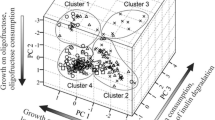Abstract
In this study, we have attempted to determine the effects of dietary fructose polymers (fructan), high molecular-weight β-(2,6)-linked levan, and low-molecular-weight β-(2,1)-linked inulin, on two intestinal enzymes (β-glucuronidase and β-glucosidase). As a preliminary experiment, when intestinal microflora were cultured in anaerobic media harboring levan or its oligosaccharides, bacterial cell growth was observed in the levanoligosaccharide-supplemented media, but not in the levan-supplemented media, indicating that levan’s size is important for the utilization by intestinal bacteria of levan as an energy source. In our animal study, the intake of a levan-rich diet was determined to significantly attenuate the activity of the harmful enzyme β-glucuronidase, but did not affect the activity of β-glucosidase.
Similar content being viewed by others
References
Kim, H., H. J. Eom, J. S. Lee, J. S. Han, and N. S. Han (2004) Statistical optimization of medium composition for growth ofLeuconostoc citreum.Biotechnol. Bioprocess Eng. 9: 278–284.
Mitsuoka, T. (1982) Recent trends in research on intestinal flora.Bifido. Microflora 1: 3–24.
Lin, J. Q., S. M. Lee, and Y. M. Koo (1992) Modeling and simulation of lactic acid fermentation with inhibition effects of lactic acid and glucose.Biotechnol. Bioprocess Eng. 9: 52–58.
Mitsuoka, T. (1992) Intestinal flora and aging.Nutr. Rev. 50: 438–446.
Hill, M. J., B. S. Drasar, V. Aries, J. Crowther, G. Hawkesworth, and R. E. O. Williams (1971) Bacteria and etiology of cancer of the large bowel.Lancet 1: 95–102.
Kinoshita, N. and H. V. Gelvoin (1978) β-glucuronidase catalyzed hydrolysis of benzo-a-pyrene-glucuronide and binding to DNA.Science 199: 307–311.
Brockett, M. and G. W. Tannock (1982) Dietary influence on microbial activities in the caecum of mice.Can. J. Microbiol. 28: 493–498.
Rhee, S. K., K. B. Song, C. H. Kim, B. S. Park, E. K. Jang, and K. H. Jang (2002) Levan. pp. 351–377. In: S. De Baets, E. J. Vandamme, and A. Steinbuchel (eds.),Biopolymers. Wiley-VCH. Weinheim, Germany.
Seo, E. S., J. H. Lee, J. Y. Cho, M. Y. Seo, H. S. Leo, S. S. Chang, H. J. Lee, J. S. Choi, and D. M. Kim (2004) Synthesis and characterization of fructooligosaccharides using levansucrase with a high concentration of sucrose.Biotechnol. Bioprocess Eng. 9: 339–344.
Bae, E. A., M. J. Han, and D. H. Kim (2001) Effect ofLentinus edodes water extract on some enzymes of mouse intestinal bacteria.Korean J. Food Sci. Technol. 33: 142–145.
Kim, D. H., H. J. Kang, S. W. Kim, and K. Kobashi (1992) pH-Inducible β-glucuronidase and β-glucosidase of intestinal bacteria.Biol. Pharm. Bull. 40: 1667–1669.
Marx, S. P., S. Winkler, and W. Hartmeier (2000) Metabolization of β-(2,6)-linked fructose-oligosaccharides by different Bifidobacteria.FEMS Microbiol. Lett. 182: 165–169.
Kang, S. K., S. J. Park, J. D. Lee, and T. H. Lee (2000) Physiological effects of levanoligosaccharide on growth of intestinal microflora.J. Korean Soc. Food. Sci. Nutr. 29: 33–40.
Gibson, G. R. and M. B. Roberfroid (1995) Dietary modulation of the human colonic microbiota: Introducing the concept of prebiotics.J. Nutr. 125: 1401–1412.
Rhee, Y. K., D. H. Kim, and M. J. Han (1998) Inhibitory effect ofZizyphi fructus on β-glucuronidase and tryptophanase of human intestinal bacteria.Korean J. Food Sci. Technol. 30: 199–205.
Rowland, I. R., A. Mallet, and A. Wise (1983) A comparison of the activity of five microbial enzymes in cecal content from rats, mice and hamster, and response to dietary pectin.Toxicol. Appl. Pharmacol. 1983: 143–148.
Srikumar, T. S. (2000) Effects of consumption of white bread and brown bread on the concentrations of bile acids and neutral steroids and on fecal enzyme activities.Nutr. Res. 20: 327–333.
Rao, C. V., D. Chou, H. Ku, and B. S. Reddy (1998) Prevention of colonic aberrant crypt foci and modulation of large bowel microbial activity by dietary coffee fiber, inulin and pectin.Carcinogenesis 19: 1815–1819.
Lee, C. M., D. W. Kim, H. C. Lee, and K. Y. Lee (2004) Pectin microspheres for oral colon delivery: preparation using spray draying method andin vitro release of indomethacin.Biotechnol. Bioprocess Eng. 9: 191–195.
Buddington, R. K., C. H. Williams, S. C. Chen, and S. A. Witherly (1986) Dietary supplement of Neosugar aliers the fecal flora and decreases activities of some reductive enzymes in human subjects.Am. J. Clin. Nutr. 63: 706–716.
Author information
Authors and Affiliations
Corresponding author
Rights and permissions
About this article
Cite this article
Kang, S.A., Chun, U. & Jang, KH. Effects of dietary fructan on cecal enzyme activities in rats. Biotechnol. Bioprocess Eng. 10, 582–586 (2005). https://doi.org/10.1007/BF02932298
Received:
Accepted:
Issue Date:
DOI: https://doi.org/10.1007/BF02932298




